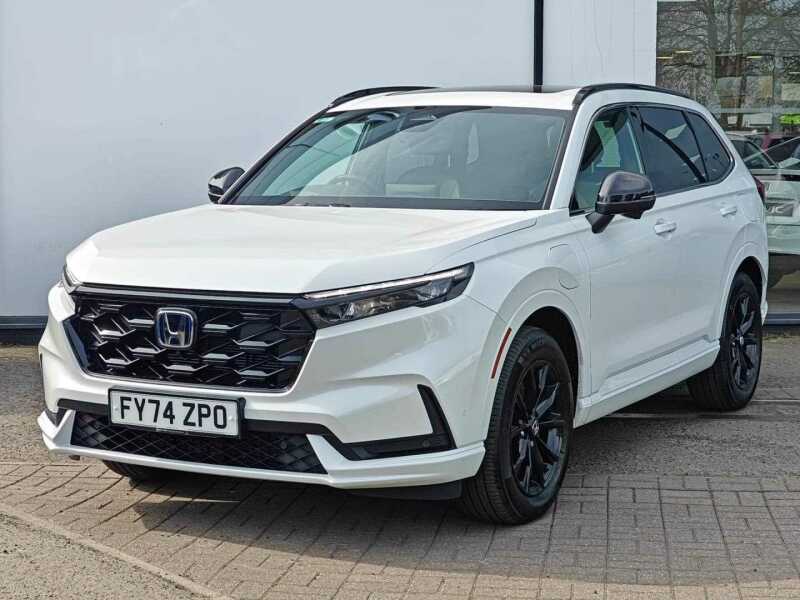Assembling the autos
Copyright 2026 heycar - All rights reserved
The Honda CR-V has been a mainstay of the SUV class since the original model debuted in 1995. An all-new car arrived in 2023, but here we’re focusing on the fifth-generation model that preceded it, which was launched in 2016 and is a common sight on the used market.
Buying a used Honda has always been a sensible decision. The brand has an excellent reputation for reliability and build quality, so while a CR-V might not be the most attractive SUV, nor the best to drive, nor even the best equipped, it’s a car you can generally trust to last you well into the future, with modest fuel bills and running costs throughout.
The fifth-generation CR-V came with petrol, diesel, and hybrid engine options too, plus front-wheel drive and four-wheel drive, and manual and automatic gearboxes, so there’s enough choice to meet most needs. Rivals such as the Toyota RAV4, Mazda CX-5, and Skoda Kodiaq are worthy alternatives, each with their own strengths, engine options, and interior and exterior style.
The original Honda CR-V launched in the mid 1990s was one of the first of a breed of cars that now pretty much dominates the market: a road-biased family SUV. It’s therefore one of Honda’s most important models and the brand has traditionally made quite an effort to ensure the CR-V is up there with the best. A sixth-generation model was launched in 2023, but the car we’re concentrating on here is the popular fifth-gen car sold from 2016.
Practicality is a CR-V strong suit. Like the smaller Jazz, the CR-V’s rear seats flip perfectly flat for a wide, open load area - something some rivals still don’t get right - while build quality is excellent. It might lack some of the touchy-feely plastics in some other vehicles but Honda tends to screw its cars together pretty well, so it should last longer than most.
The infotainment options are a little dated but most later cars at least got Apple CarPlay and Android Auto, so the built-in features will be less of a concern anyway. Later cars are also hybrid-powered - the hybrid model was introduced in 2019 but it was the only setup offered from 2020-onwards, so if you prefer regular petrol or diesel, you’ll have to look for an earlier car.
The CR-V drives well though. It’s not one of the sportier SUVs on the market but it’s comfortable and its ride quality makes the best of poor road surfaces. In hybrid form especially it’s also quiet and easy to drive. Competition comes in the form of the Toyota RAV4, another predominantly hybrid Japanese SUV (and another early entrant to the market), while the similarly-sized Mazda CX-5 is sportier and better to look at inside and out. Don’t ignore the Skoda Kodiaq and its VW Tiguan and SEAT Tarraco equivalents either, which are well-built and good to drive.
The hybrid is probably the best long-term bet in the CR-V range, especially if you live in a city like London where emissions-based charging is used. Not only does the hybrid’s Euro 6d rating mean it currently avoids the ULEZ charge, but it’s likely to remain that way after some of the other models have fallen foul. And in the meantime, it’s frugal and easy to drive. If fuel economy is your main concern and you never go near London then the old 1.6-litre diesels are very frugal, even if they may not reach the official, older NEDC figures quoted further down.
In terms of specification, we’d focus on mid-range SE and SR models, unless you find a higher-spec EX or distinctive Sport Line for a good price on the used market. All CR-Vs are well-equipped, though without an infotainment display, the basic S does feel a little old-hat.
The models covered below refer to the fifth-generation CR-V offered between 2016 and the introduction of the latest model in 2023. Honda shook up the engine lineup over that time, as you’ll have read above, with hybrid power only from 2020 onwards, something that has continued with the latest car. Trim levels remained fairly consistent, though you can expect slightly more kit (and more modern features) the later the CR-V you’re looking at.
The Honda CR-V’s dimensions are:
The Honda CR-V’s boot size is:
While the latest CR-V launched in 2023 exceeds the £40,000 mark in some variants, and therefore attracts a VED surcharge, the model we’re concentrating on here wasn’t quite that expensive, so gets a lower flat rate across the range. Petrol and diesel models will cost you £190 per year in the 2024/2025 tax year, while the hybrid is considered an ‘alternative fuel vehicle’, so its bill drops to £180. Some models registered prior to April 2017 may be cheaper still, as their tax is CO2 based - the 1.6 diesel comes in at only £35 per year.
The cheapest of the hybrid CR-Vs starts in insurance group 22, for a model in S trim, with EX models in group 24. The older 1.5-litre turbo tops out at group 25 in EX trim. This is more expensive than you’ll find in some rivals though, as a Ford Kuga starts in only group 10.

£23,592

£39,995
£13,550
£23,686
£1,026 off£32,163
£1,089 off£17,790
£18,526
£32,795
£24,603
£725 off£21,950
£16,702
£702 off£34,950
£21,190
£1,818 off£21,954
£23,990
£32,990
£33,399
£10,490
1-18 of 244 vehicles
What is the average mileage for Honda CR-V ?
27839
How many Honda CR-V cars are available for sale?
261